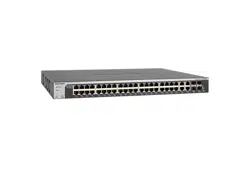Loading ...
Loading ...
Loading ...

Configuration Examples
368
ProSAFE 10-Gigabit Smart Managed Switch XS728T and XS748T User Manual
When a port is enabled for bridging (the default) rather than routing, all normal bridge
processing is performed for an inbound packet, which is then associated with a VLAN. Its
MAC destination address (MAC DA) and VLAN ID are used to search the MAC address
table. If routing is enabled for the VLAN, and the MAC DA of an inbound unicast packet is
that of the internal bridge-router interface, the packet is routed. An inbound multicast packet
is forwarded to all ports in the VLAN, plus the internal bridge-router interface, if it was
received on a routed VLAN.
Since a port can be configured to belong to more than one VLAN, VLAN routing might be
enabled for all of the VLANs on the port, or for a subset. VLAN routing can be used to allow
more than one physical port to reside on the same subnet. It could also be used when a
VLAN spans multiple physical networks, or when additional segmentation or security is
required.
Complete these steps to configure a switch to perform interVLAN routing:
1. Use the IP Configuration page to enable routing on the switch.
For more information about this step, see IP Configuration on page 34.
2. Determine the IP addresses that you want to assign to the VLAN interface on the switch.
For the switch to be able to route between the VLANs, the VLAN interfaces must be
configured with an IP address. When the switch receives a packet destined for another
subnet/VLAN, the switch looks at the routing table to determine where to forward the
packet. The packet is then passed to the VLAN interface of the destination. It is then sent
to the port where the end device is attached.
3. Use the VLAN Routing Wizard page to create a routing VLAN, configure the IP address and
subnet mask, and add the member ports.
For more information about this step, see Use the VLAN Static Routing Wizard on
page 169.
4. Use the VLAN Routing Configuration page to view or modify the VLAN as a routing VLAN.
In the following figure, VLAN 30 is a routing VLAN with IP address 10.1.1.1 and subnet
mask 255.255.255.0. (For more information about this page, see VLAN Routing
Configuration on page 171.)
Loading ...
Loading ...
Loading ...
